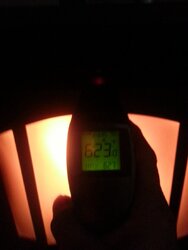So, I'm new to pellet stoves and have only had one for a couple of months. As many here recommend, I bought approximately 12 different brands of pellets and tried them all. Unfortunately, I didn't own an infrared thermometer while going through the first four brands or so, but I got temp readings for the latter brands.
The very first brand I tried was Fireside Ultras. Again, I didn't have the thermometer yet, but they seemed to burn an awful lot hotter than the next few brands I bought. When I finished with all the rest of the other brands, the Fireside Ultras seemed like a logical choice to buy for the season (3 tons). Especially since others here were reporting them as burning hot and they coincidentally happened to be the cheapest pellets I found I found at a little over $200/ton.
Now that I'm burning them exclusively, and have the ability to measure those temps at the room blower vents, they don't seem particularly hot.... just kind of mid-range. I really wish I had my thermometer from the beginning rather than just anecdotal information, but I'm feeling pretty confident that I'm not getting the same heat that I did initially.
I'm curious if it might be as simple as these three tons being from a different batch, or is it because my stove is not as clean as new?
I've read of pellet brands varying in quality from season to season, but do they also have quality variances from batch to batch? Can a person assume that if they bought Brand X today and liked the results, that the quality would be the same 2 months later? Or do you guys buy a few bags from a specific batch before committing to tons for the season?
And, if it's the stove, is it normal to maybe have a 60 degree difference in the temp readings between a "Clean as new" stove and one that's been used for a couple of months? I THINK I'm cleaning it pretty thoroughly...and yesterday in particular did a really thorough job around the heat exchange tubes. The only thing that has not been well-cleaned is the vent pipe.
What say you, Pellet Aficionados?
The very first brand I tried was Fireside Ultras. Again, I didn't have the thermometer yet, but they seemed to burn an awful lot hotter than the next few brands I bought. When I finished with all the rest of the other brands, the Fireside Ultras seemed like a logical choice to buy for the season (3 tons). Especially since others here were reporting them as burning hot and they coincidentally happened to be the cheapest pellets I found I found at a little over $200/ton.
Now that I'm burning them exclusively, and have the ability to measure those temps at the room blower vents, they don't seem particularly hot.... just kind of mid-range. I really wish I had my thermometer from the beginning rather than just anecdotal information, but I'm feeling pretty confident that I'm not getting the same heat that I did initially.
I'm curious if it might be as simple as these three tons being from a different batch, or is it because my stove is not as clean as new?
I've read of pellet brands varying in quality from season to season, but do they also have quality variances from batch to batch? Can a person assume that if they bought Brand X today and liked the results, that the quality would be the same 2 months later? Or do you guys buy a few bags from a specific batch before committing to tons for the season?
And, if it's the stove, is it normal to maybe have a 60 degree difference in the temp readings between a "Clean as new" stove and one that's been used for a couple of months? I THINK I'm cleaning it pretty thoroughly...and yesterday in particular did a really thorough job around the heat exchange tubes. The only thing that has not been well-cleaned is the vent pipe.
What say you, Pellet Aficionados?




